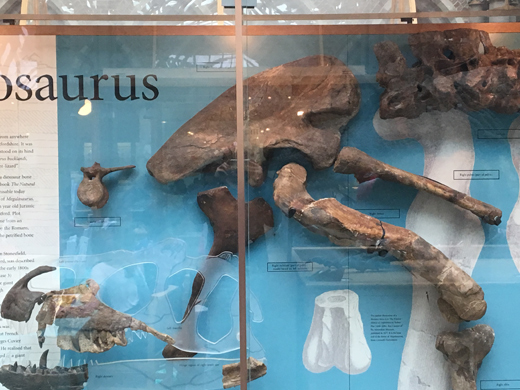What’s in a Name – The Classification of Dinosauria
How the Dinosauria came to be Named
The classification of Dinosauria into a separate and distinct order is shrouded with controversy. It may be widely known that the term “Dinosauria” was first used by Sir Richard Owen, how the term came into being and accepted by the scientific community is quite contentious.
Linking the Fossil Evidence
A number of attempts had been made link the three known ancient land dwelling reptiles – Iguanodon, Megalosaurus and Hylaesaurus in the early 1830s. The distinguished German naturalist Hermann von Meyer (who was later to name and describe Plateosaurus in 1837), had used the phrase “Saurians” when describing these animals and their mammalian characteristics in a paper published in 1832.
However, it was a fossil unearthed in 1841 that finally provided the evidence to unite all these huge land reptiles into a separate taxon. A new bone of an Iguanodon had been discovered on the Isle of Wight. This new discovery was brought to the attention of Richard Owen and he duly went off to the island to examine it. The fossil was an Iguanodon’s sacrum (the lower part of the spine). As Owen studied this new find it dawned on him that the Iguanodon sacrum had an identical characteristic to the sacrum of the Megalosaurus that had been on display at the Ashmolean museum, Oxford for the past twenty years or so.
Megalosaurus Fossil Material on Display

The Megalosaurus display case (Oxford Museum of Natural History). Picture credit: Everything Dinosaur.
Picture credit: Everything Dinosaur
Five Sacral Vertebrae
The five sacral vertebrae forming the lower part of the spine of both the Iguanodon and Megalosaurus were fused in exactly the same way. Having a fused sacrum strengthens the backbone and is an adaptation for living on land, dinosaurs have it as do mammals and humans (although our lower spines are fused in a different way to dinosaurs). This fossil vertebrae provided the vital evidence of an anatomical link between the meat-eating Megalosaurus and the plant-eater Iguanodon. They belonged to the same order.
Prior to this, these reptiles had been loosely grouped together under the term “Lacertians” but now these land animals were seen as a very distinct group from crocodiles, marine reptiles and pterosaurs. They had characteristics very similar to mammals, with an upright gait, pillar like legs that were held directly underneath the body.
Richard Owen
Richard Owen had been engaged by the British Association for the Advancement of Science (BAAS) to produce a comprehensive paper on these ancient creatures – his “Report on British Fossil Reptiles”. He delivered his paper in a presentation made at the annual meeting of the BAAS in August 1941, but extensively re-wrote it before its final publication in April 1842. Working from his study at the Royal College of Surgeons in London, Richard added the following note to his paper:
“The combination of such characters, some as the sacral ones, altogether peculiar among Reptiles, others borrowed, as it were, from groups now distinct from each other, and all manifested by creatures far surpassing in size the largest of existing reptiles, will, it is presumed, be deemed sufficient ground for establishing a distinct tribe or sub-order of Saurian Reptiles for which I propose the name of Dinosauria”.
Richard Owen had toyed with a number of names for this new classification over the winter of 1841 but after discussing the matter with friends he hit upon the idea of using the Greek words “deinos” meaning terrible or fearfully great and “sauros” meaning lizard.
The Classification of Dinosauria
Hence the term dinosaurs or terrible lizards came into being.
Perhaps Owen had been pointed in the direction of the Greek poetic style of Homer as the word “Deinos” is found in the work accredited to the ancient Greek poet. In the prose, the word Deinos is used to mean inconceivable and unknowable, a very apt description; as few scientists could fail to recognise the impact of the establishment of a extinct sub-order of reptiles on the prevailing view about the Creation.
Mystery Surrounds the Naming of the Order
Mystery surrounds the naming of this order, much of the earlier work of Mantell is discredited in Owen’s paper. Indeed he takes credit for many of the insights made by Mantell and others. Poor Mantell is ridiculed for his inaccurate estimates of the size of Iguanodon. Owen takes great delight in belittling Mantell’s comparisons of the fossils of Iguanodon with a modern Iguana. He almost gleefully, mocks Mantell for naming Iguanodon from the fossil teeth resembling that of an Iguana lizard.
Owen states that the teeth when studied in cross-section under a microscope bare little similarity. This is a little unfair, as at the time Mantell made his conclusions fewer Iguanodon fossils were known and he did not have access to a microscope.
Mantell and the Classification of Dinosauria
Ironically, it was Gideon Mantell who first pointed out the bipedal stance of Iguanodon. He had noted a number of characteristics regarding the limb bones of Iguanodon that led him to conclude that this animal was capable of standing on its hind feet using its forelimbs for grasping vegetation. Owen completely failed to notice this despite having better access to fossil specimens of Iguanodon than Mantell. Owen envisaged Iguanodon as an elephantine type quadruped whereas it was Mantell who had given us the first insight into the true nature of anatomy of dinosaurs.
Dinosaur Models: Dinosaur and Prehistoric Animal Models.

